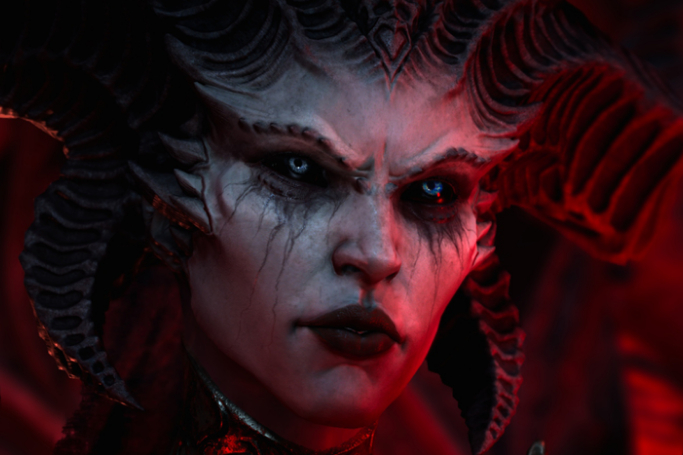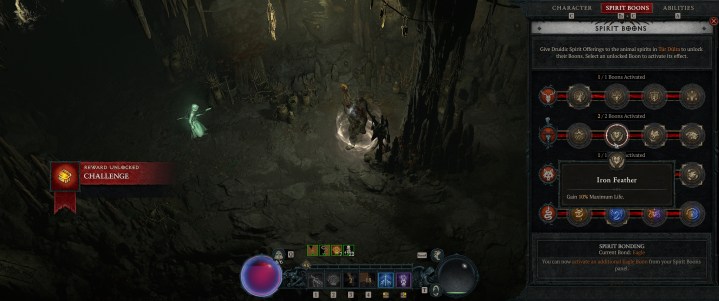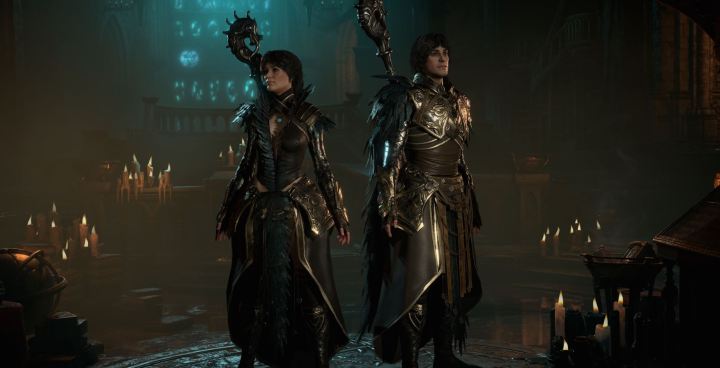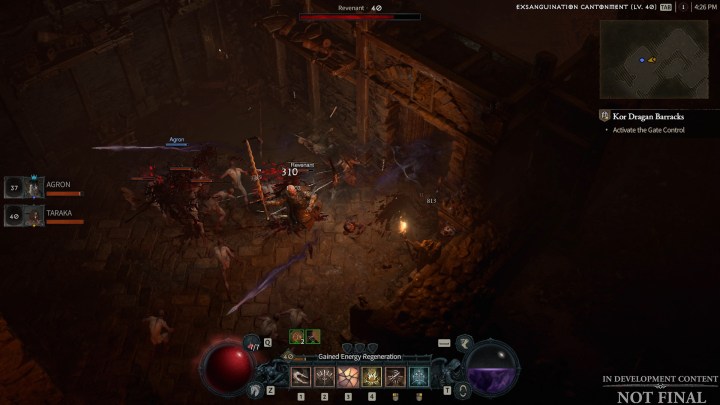
“Diablo 4’s wealth of loot and meaningful customization systems make up for most of its frustrating MMO concessions.”
Pros
- Frenetic combat
- Lots to see and do
- Deeply engaging stories
- Robust character customization
- Meaningful progression
Cons
- Frustrating always-online setup
- Slow start
I was walking toward the city of Kyovashad’s western thoroughfare when I was distracted by a glowing blue checkmark guiding me to a woman in need of my assistance. This was the first of many enticing Diablo 4 side-missions: Locate a monk who went missing en route to the village of Menestad to the north. Intrigued, I took the quest and set off on my journey.
On the way there, I came upon a luminescent cavern entrance and went inside, slaughtered swarms of foes, and gathered up more treasure than you’d find in Tristram’s old cathedral. About 20 hours of well-written quests, frantic open-world events, and mindless dungeon crawls later, my buffed-up level 35 Druid had already traipsed across all five of the open-world zones and somehow had yet to even approach the first quest of the first act of the main story.
What caught my eye instead were the many nooks and crannies of Sanctuary, a world filled to the brim with intriguing stories that I didn’t expect from a game so classically focused on killing demons to make numbers go up. In the time it took me to reach the cusp of level 50, I beat the majority of the main story and saw plenty of grim tales come to life with personal writing and engaging voice acting befitting a big-ticket RPG.
Frankly, I can’t wait to return to Diablo 4 for another round once all my friends can join me.
Lilith in chains
Like previous installments of the series, Diablo 4 is a dark dungeon-crawling RPG where players hack through hundreds of enemies and collect valuable loot for doing it. Several tweaks have been made to the formula this time around, making it more of a modern MMO meant to keep players logging in longer. To accomplish that task, the RPG has taken what the series has always done well and buffed those aspects up even more, much like equipping a better set of gear on a character.
Class customization is leaps ahead of Diablo 2: Resurrected and Diablo 3.
Diablo‘s Sanctuary is rich with grisly lore, and this has never been more apparent than in Diablo 4. The big villains are ambiguous in their motives but decidedly evil in their methods, and they’re played brilliantly throughout the campaign. Moreover, the graphical fidelity, music, and sound design are all top-tier, which is surprising given its frustrating always-online nature. One of the earliest pieces of evidence of its masterful cohesion between action, worldbuilding, and storytelling was a side-quest in the starting zone that had me exploring a frozen clearing for a villager’s husband, only to find him bound and flayed alive, begging for more devastation –- a clear nod to Hellraiser.
All five of Diablo 4’s zones are chock full of moments like that. One takes place in the unmistakably Celtic-inspired woodland region of Scosglen, and the shock factor elicited by its body horror is deftly woven into the broader plot in a way that is signature to the series. Let’s be clear: This is the darkest Diablo has ever been, and thematically speaking, blows Diablo 2’s brooding Gothic atmosphere out of the water.
Of course, it wouldn’t be a proper Diablo game without deep character classes that offer plenty of space for customizing your own playstyle once the fighting starts. Class customization is leaps ahead of Diablo 2: Resurrected and Diablo 3, especially at later levels, and this is due to an extensive class-based skill tree that’s more thorough and forgiving than that of Diablo 4’s predecessors. Classes are broken down thoroughly enough to grant a ton of space to experiment with different skills and passive stat boosts that often incentivize specific styles of play, and this is far more evident at higher levels –- when you’ve earned your Ultimate and Key Passive abilities, which are total game-changers and could even be said to change the way a given character functions at a core level.

I gave my Druid a Key Passive ability that made his Storm spells intermediately trigger equivalent spells of the opposite element; in practice, this meant each lightning bolt he slung would also have the chance to spawn fissures erupting from under the recipient’s feet, dealing twice as much damage. I combined this with one of the Druid’s four Ultimate abilities; specifically, the one which summons an entire lightning storm replete with tornadoes. Mixing these abilities together, a lucky roll of the dice meant cataclysmic destruction for my foes when a minor earthquake accompanied the rather unpleasant weather I’d cast upon them.
Class progression is augmented by all sorts of useful boosts; each class kit comes with a tertiary progression system in addition to skills and equipment — and the way these systems work varies wildly from class to class. For instance, the Druid unlocks its Spirit Boons by completing an entire side-quest chain and establishing a foothold for Druids in Scosglen, and once I did this, I was able to allot a specialized resource to help make myself far more powerful in specific ways than I would’ve been had I chosen to skip that quest altogether. Each of the four Druid totems is themed differently as well, and I found that I could shift my Spirit Boons to accommodate very different styles of play. Fortunately, there’s little penalty for experimenting with different approaches to your class, aside from a few gold coins if you choose to refund your skill points at higher levels.
Gimme the loot
This level of class depth goes above and beyond anything I’ve seen in any ARPG aside from Path of Exile or perhaps Lost Ark, though it’s still rare to see items that are individually powerful enough to completely change the way you play at early levels. The lack of a “wow” factor in Diablo 4’s loot in the first 20 hours felt like a jarring departure from Diablo 2, and it immediately made me begrudge the fact I was playing an always-online pseudo-MMORPG rather than a single-player RPG that didn’t need to worry about balancing tons of online player characters.
It takes a while to get going, but it’s worth the time invested into your character.
At later levels, I found I’d accumulated enough legendary gear pieces and high-level gems to deliberately hone in on a specific playstyle that’d have been unachievable had I not had those items equipped, and I have to laud Diablo 4 for how much customization exists at those higher levels. It takes a while to get going, but it’s worth the time invested into your character.
Each piece of gear in Diablo 4’s arsenal generally only influences a few traits and stats — generally within your class’s skill tree — instead of introducing new mechanics entirely. You can’t find a flaming sword or a weapon that shoots lightning bolts, but you might find a staff that makes your Druid’s poison spells a little more potent or changes the effect of your lycanthrope skills, for instance. This is generally fine because Diablo 4’s class system is strong enough to make it work. And thanks to the upgrading system, it isn’t necessarily just a loot treadmill where you constantly have to throw your best pieces away in pursuit of constant marginal increases to your character’s stats.

In place of Diablo 3’s crafting system, you can now upgrade your existing gear, imprint legendary “aspects” with powerful stat boosts earned by completing dungeons, and add gem sockets at NPCs to keep your best equipment for a longer amount of time. This afforded me way more control over my Druid’s playstyle, especially once I discovered a skill rotation that I really enjoyed using over and over again in combat.
It’s a big world after all
The breadth of content in Diablo 4’s open world is remarkable, and thanks to its intelligent level-scaling system, you can basically walk in any direction and find a plethora of things to do at any given moment (and more regions will gradually become available as you level up). I still haven’t seen Ashava or any of the other world bosses, given the review servers weren’t populated by more than a handful of players at a time. In spite of not getting to engage with multiplayer-focused content, not once did I ever feel like I couldn’t tackle a quest or dungeon on my own.
And boy, do they have those in spades.

These are often satisfying, especially since each dungeon pulls from a region-appropriate tileset and has a unique boss with its own special mechanics at the end. While you can skip dungeons altogether in favor of story quests, they’re easily the best way to level up and find powerful loot quickly, even though it can feel repetitive and grindy to go through every single dungeon if you want to complete the world map. Luckily there are a ton of demons, beasts, and undead creatures to slay no matter where you go.
I’m deeply impressed at how Diablo 4 handles its open world with five distinct regions. After a certain point in the main quest, you do eventually get your own mount, and it’s handy to be able to ride — rather than run — through this rather large world. However, I had a genuine blast running from one end of the world to the other on foot, killing everything in my path and reaping more than enough loot to upgrade my gear several times over.
Having spent almost 1,000 hours in The Elder Scrolls Online, I was initially turned off by the presence of a level-scaling system that seemed to hollow out my progress in a way that was all too familiar to me, but it genuinely grew on me by the end of my playthrough. On one hand, the level-scaling system ensures you’re always treated to a challenge and interesting rewards no matter where you go. On the other hand, I’m amazed at how well-handled this system can be when two or more players of vastly different levels are interacting and fighting swarms of monsters in the same space.
What Diablo 4 has accomplished is a fundamental improvement to the hack-n-slash ARPG genre, and it’s a hell of a lot of fun.
Through seemingly complex mechanical wizardry, Diablo 4 competently walks the line between making enemies feel consistently challenging no matter where you go or what level your character is, and it still makes you feel a palpable sense of improvement when your character is fully leveled up and has all of their skills.
Equally impressive to this balancing act in gameplay is Diablo 4’s commanding audio design. The brilliantly occult and creepy tones of Diablo 2’s soundtrack are back with an experimental, diverse, ambient, and sometimes energetic musical score that reflects the cultural tones of each of its five major zones. The Eastern European themes of the Fractured Peaks differ greatly from those of the Scotland-inspired realm of Scosglen, or the sandy slopes of Kehjistan which feature Middle-Eastern sounds that strongly channel Lut Gholein from Diablo 2. Diablo 4’s hauntingly beautiful musical score perfectly complements its exceptional sound design. With expert use of audio spatialization, the game crafts a chaotic symphony of sounds that filled my awareness, turning every battle into a satisfying sonic spectacle and lending a palpable sense of presence to each character during the immersive cinematic cutscenes and dialogue sequences.

I experienced a few technical hiccups due to an abrupt loss of connection to Diablo 4’s servers but never encountered any crashes or bugs to detract from the game’s general level of polish. This is a tight ship from top to bottom, and unless the servers totally break down on day one, my fingers are crossed for a smooth and otherwise bug-free launch. That said, it’s worth raising the concern that Activision-Blizzard is priming itself to make a big deal of Diablo 4’s post-launch support, and the extent to which it plans on integrating microtransactions or pay-to-win content is dubious as of this review’s writing. Despite knowing a cash shop is planned to roll out when the servers go live next week, I didn’t see the cash shop with my own eyes during my review window. Though, as with any other online game, both the company’s practices and the general gameplay experience are subject to change at any time. Still, what Diablo 4 has accomplished is a fundamental improvement to the hack-n-slash ARPG genre, and it’s a hell of a lot of fun.
Diablo 4 strides out of the gate with an impressive blend of engrossing storytelling, engaging gameplay, and top-tier audio-visual design. As a result, it stands as a groundbreaking addition to the ARPG genre, despite my hovering concerns about its compulsory persistent multiplayer and potential future microtransactions.
Diablo 4 was reviewed on PC.
Editors’ Recommendations
Stay connected with us on social media platform for instant update click here to join our Twitter, & Facebook
We are now on Telegram. Click here to join our channel (@TechiUpdate) and stay updated with the latest Technology headlines.
For all the latest Gaming News Click Here
